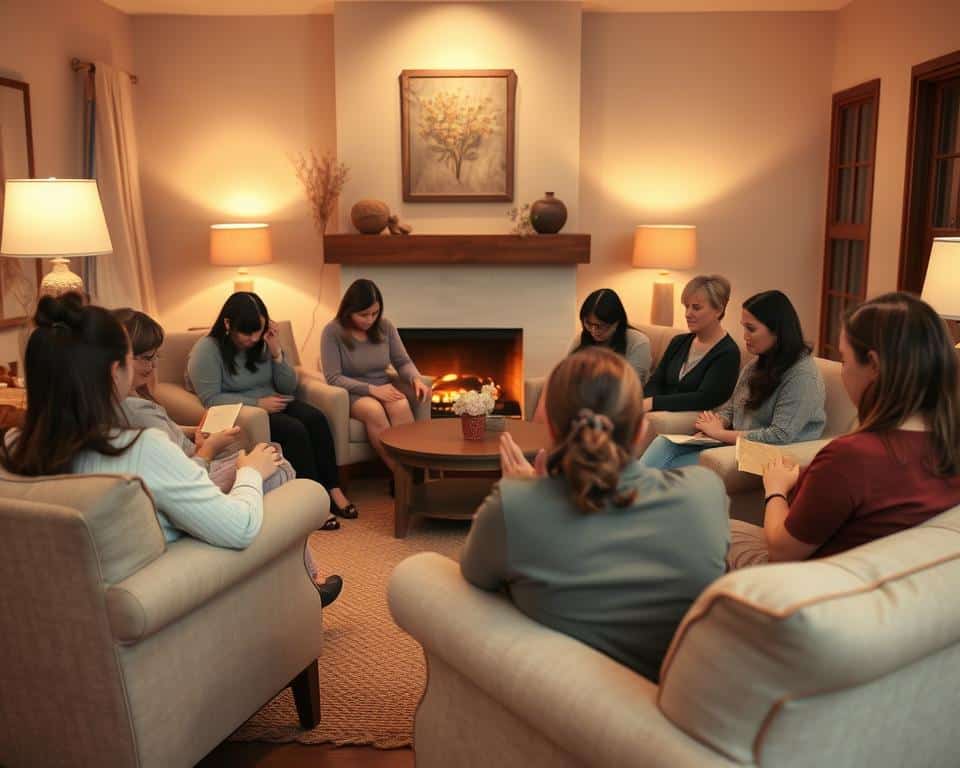Gathering with others to share faith and hope can transform your home into a sacred space. Jesus said, “Where two or three gather in my name, there am I with them” (Matthew 18:20). This promise makes small, intentional meetings powerful.
Starting a faith-based gathering at home strengthens relationships and deepens trust in God’s word. It’s simpler than you think—no fancy setup required. Just an open heart and a desire to grow together.
You’ll discover how to create meaningful connections while overcoming common challenges. Let’s explore practical ways to build a supportive community right where you live.
1. Prepare Your Space for Prayer
A well-prepared space invites peace and connection during faith gatherings. Whether indoors or outdoors, focus on comfort and simplicity. A distraction-free zone helps members center their hearts on God’s word.

Choose a Quiet and Comfortable Area
Pick spots like living rooms or porches with ample seating. Soft lighting or candles set a calming tone. If weather permits, parks offer a refreshing change of scenery.
Gather Essential Supplies
Keep Bibles, journals, and worship music nearby for reflection. Printed prayer lists from your congregation help guide requests. Tactile elements like communion bread or prayer cloths deepen the experience.
Pro Tip: Rotate locations or décor occasionally to keep ideas fresh. Small changes can make activities feel new and engaging.
2. Set a Clear Purpose for Your Prayer Group
A clear direction makes every gathering meaningful and impactful. Without it, meetings can feel scattered or repetitive. Define a simple purpose—like studying God’s word or supporting one another—to guide your time together.

Define the Focus of Each Meeting
Assign themes like “gratitude” or “missions” to structure discussions. Rotate topics weekly to keep things fresh. For example, one week could explore Psalm 103:1-5, highlighting God’s faithfulness.
Tip: Ask, “How does this passage guide us today?” to spark reflection. Short devotionals led by different members add variety.
Share a Bible Passage or Testimony
Open with Scripture—Psalms work well for setting a hopeful tone. Testimonies about answered prayers remind everyone of God’s work in daily life. Keep stories brief to leave room for group input.
Invite members from your church to share their experiences. This builds trust and reinforces the power of faith in action.
3. Structure Your Prayer Time Effectively
A structured approach keeps your faith gatherings focused and meaningful. Clear sections help avoid rushed or uneven moments. You’ll create space for both deep reflection and joyful worship.
Divide Time into Manageable Sections
Start with a 5-minute welcome to set the tone. Move into 40 minutes of themed stations—like gratitude or missions. Alternate between silent reflection and spoken requests to keep everyone engaged.
Pro Tip: Use a timer to stay on track. Dedicate one meeting each week to thanksgiving-only prayers. This builds hope and reminds everyone of God’s faithfulness.
Include Worship and Reflection
Begin with a Scripture, like Psalm 100:4, to center hearts. Soft music transitions between sections help shift focus. End with shared praises—brief stories of answered prayers uplift the group.
Rotate leaders for devotionals to add variety. Keep worship simple: a hymn or instrumental playlist works well. This balance ensures no single part overpowers the rest.
4. Engage Everyone in the Group
Active participation makes faith gatherings vibrant and meaningful for everyone. When people contribute, the shared experience deepens connections and strengthens faith. Here’s how to ensure all voices are heard.
Mix Up Prayer Styles
Try the “popcorn prayer” method—short, spontaneous prayers spoken aloud by anyone. This keeps energy high and invites quieter members to join when ready. Rotate these prayer ideas:
- ABC trios: Split into groups of three. Assign roles—A shares a request, B prays, C affirms with Scripture.
- Multilingual prayers: If your group speaks different languages, welcome prayers in each tongue.
- Printed prompts: Provide cards with verses or questions to guide hesitant participants.
Create Space for All Members
Invite quieter individuals to read Scripture aloud or light a candle as a silent prayer. Pair new attendees with regulars to build comfort. Pro Tip: Start with icebreakers like, “Share one way God blessed you this week.”
Small adjustments ensure everyone feels valued. These ways foster unity and remind us that every voice matters in God’s family.
5. Hosting Prayer Groups with Themes
Themes add depth and focus to your gatherings, making each meeting unique. They help direct conversations and create a shared purpose. Whether studying Scripture or supporting one another, a central idea ties everything together.
Select Relevant Topics for Each Meeting
Rotate monthly themes like “Global Missions” or “Healing” to explore different aspects of faith. For example, display a world map when praying for specific countries. This visual reminder connects hearts to needs beyond your community.
Share fresh ideas from your church or Bible study. Topics like “Youth Challenges” or “Gratitude” invite personal stories. Pro Tip: Let members suggest themes—ownership increases engagement.
Incorporate Activities or Visual Aids
Interactive activities make abstract concepts tangible. Pass around family photos during intercession to personalize requests. Use scented oils for anointing rituals, linking senses to faith.
Bake communion bread together as part of worship. Simple, hands-on tasks deepen understanding. These methods turn Scripture into lived experiences, not just words.
6. Foster a Supportive Community
Strong relationships form when people unite in faith and purpose. Your gathering becomes more than a meeting—it grows into a family that bears burdens together. Galatians 6:2 reminds us to “carry each other’s burdens,” and this starts with intentional care.
Build Trust Through Shared Faith
Trust deepens when members consistently show up for one another. Start by pairing newcomers with seasoned believers for mentorship. This creates safe spaces for vulnerability.
Try these simple practices:
- Keep a shared journal or digital doc to track ongoing needs
- Begin meetings with “rose and thorn” check-ins—one joy and one challenge
- Rotate who opens with personal testimonies of God’s faithfulness
Follow Up With Care
Following through on requests shows your community’s love is real. Send midweek texts like, “Still lifting up your job situation!” or drop off meals during tough seasons.
Leaders can set the tone by:
- Hosting quarterly potlucks to celebrate answered prayers
- Creating a praise board to visualize God’s work
- Sharing brief updates during worship time
When care extends beyond meetings, faith becomes tangible. Your group will thrive as a living example of 1 Thessalonians 5:11: “Encourage one another and build each other up.”
7. Keep Your Prayer Group Growing
Keeping your faith circle vibrant requires fresh ideas and shared leadership. Rotate hosting duties to involve more families—it builds ownership and spreads the joy of service.
Try hybrid meetings for wider reach. A YouTube channel lets distant members join live or watch later. Teens co-leading sessions bring energy and relatable perspectives.
Survey members yearly for feedback. Partner with neighboring churches for joint events, strengthening bonds across communities. Every step nurtures a faith-filled life together.
Start small: Pick one idea this month. Watch how God multiplies your efforts.





